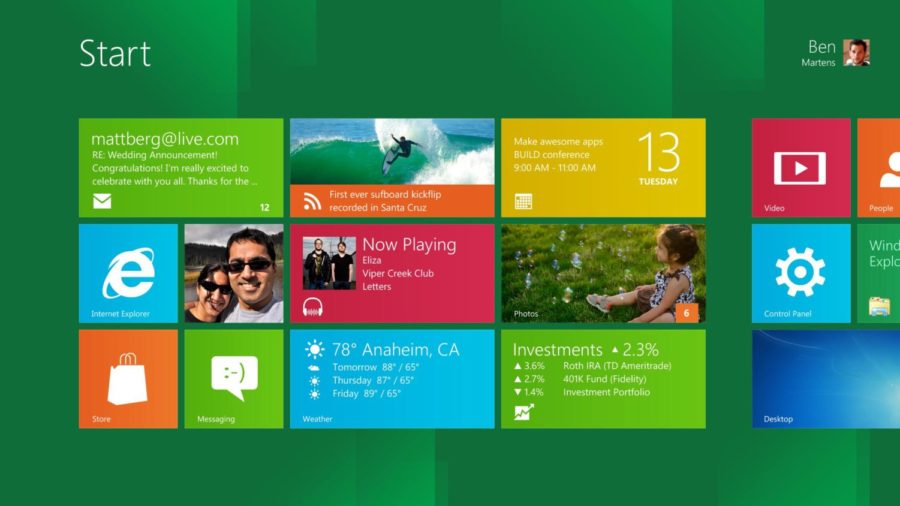Microsoft unveils a radically redesigned Windows 8
Microsoft formally introduced Windows 8 on Tuesday, September 13, 2011, to thousands of software developers gathered at the company’s annual Build conference in Anaheim, Calif. The software giant said it re-imagined Windows for the “changing world of computing.”
September 13, 2011
Windows 8 is coming soon — and it looks nothing like the Windows you’re used to.
Microsoft formally introduced Windows 8 on Tuesday to thousands of software developers gathered at the company’s annual Build conference in Anaheim, Calif. The software giant said it reimagined Windows for the “changing world of computing.”
Windows 8 has a completely new visual interface, optimized for touchscreens on mobile devices like tablets.
The result is a computer that operates as a kind of hybrid PC and media tablet, with all the functions of a standard PC operating system but the user experience of a tablet.
Windows 8 is designed to be “touch first, but equally at home with mouse and keyboard,” said Steven Sinofsky, Microsoft’s Windows division president.
The changes can’t come soon enough for Microsoft: Apple’s iPad is cutting deeply into PC sales, setting off warning bells for companies like Microsoft that rely heavily on consumers buying new PCs. Windows 7, which has been on the market for two years, only recently eclipsed Microsoft’s decade-old Windows XP in its number of users.
Windows 8 launched in “preview mode” on Tuesday for developers to toy around with. It didn’t work perfectly in Microsoft’s demonstration, but software in this early stage of development often is bug-ridden.
Still, the preview revealed a refined, simple, and in many ways elegant user interface that looks very similar to Microsoft’s mobile operating system, Windows Phone 7. The change will mark Windows’ biggest visual overhaul in decades.
Users begin with an opening screen that looks a bit like Microsoft’s Bing search engine home page. A large photo takes up the majority of the screen, with icons that show the user how many e-mails, messages and notifications are waiting for them.
After the user logs in, they reach a “start screen” featuring interactive tiles that launch with a tap of the finger or the click of a mouse. Unlike most tablets on the market today, Windows 8-powered devices will be able to launch applications side-by-side. That means users can multitask between, say, a movie and an instant messaging program.
Behind the user interface, which Microsoft dubs “Metro,” is a streamlined operating system that Microsoft says runs more efficiently than the current version of the OS, Windows 7.
“Everything that was great for Windows 7, we took that and made it better for Windows 8,” said Sinofsky.
To prove it, Sinofsky demonstrated Windows 8 operating on a three-year old, first-generation netbook. Using Windows Task Manager, he showed that Windows 8 actually used less memory than the netbook did while running Windows 7. He also demonstrated everyday PCs, laptops and tablets that booted in less than 10 seconds.
That efficiency is hugely important to customers, who roundly rejected Windows Vista for its chunkiness. A lightweight OS is even more important now as tablet computers grow in popularity.
That’s particularly crucial for Windows 8, because for the first time, Windows will work on power-sipping ARM-based chips made by Qualcomm, Samsung, and Texas Instruments, among others.
“I promise you we did not lose sight of fundamentals,” Sinofsky said.
But make no mistake: Windows 8 is a PC operating system. It may be optimized for touch and mobile, but applications are largely bifurcated into “Metro-style” apps and desktop applications.
There are applications that just won’t work on a tablet user interface that are going to look and feel a whole lot like your old-fashioned point-and-click Windows-based software.
For example, one press of a Windows button switches back and forth between the Metro experience and the desktop experience. Windows 8, in a sense, has two interfaces.
In other words, Microsoft is betting that people want a full PC experience on the go and a tablet-like experience on their PCs. That’s very different from the approach by Apple or Google, which build two separate operating systems for PCs and mobile devices.
Microsoft began revealing some of Windows 8’s features as early as June. In a YouTube video, the company showed off some aspects of the new “Metro” user interface, and since then, the company has been giving weekly sneak peaks in a blog written by Sinofsky. The company hasn’t yet set a launch date for Windows 8, but it has hinted that its new operating system will begin rolling out in 2012.







